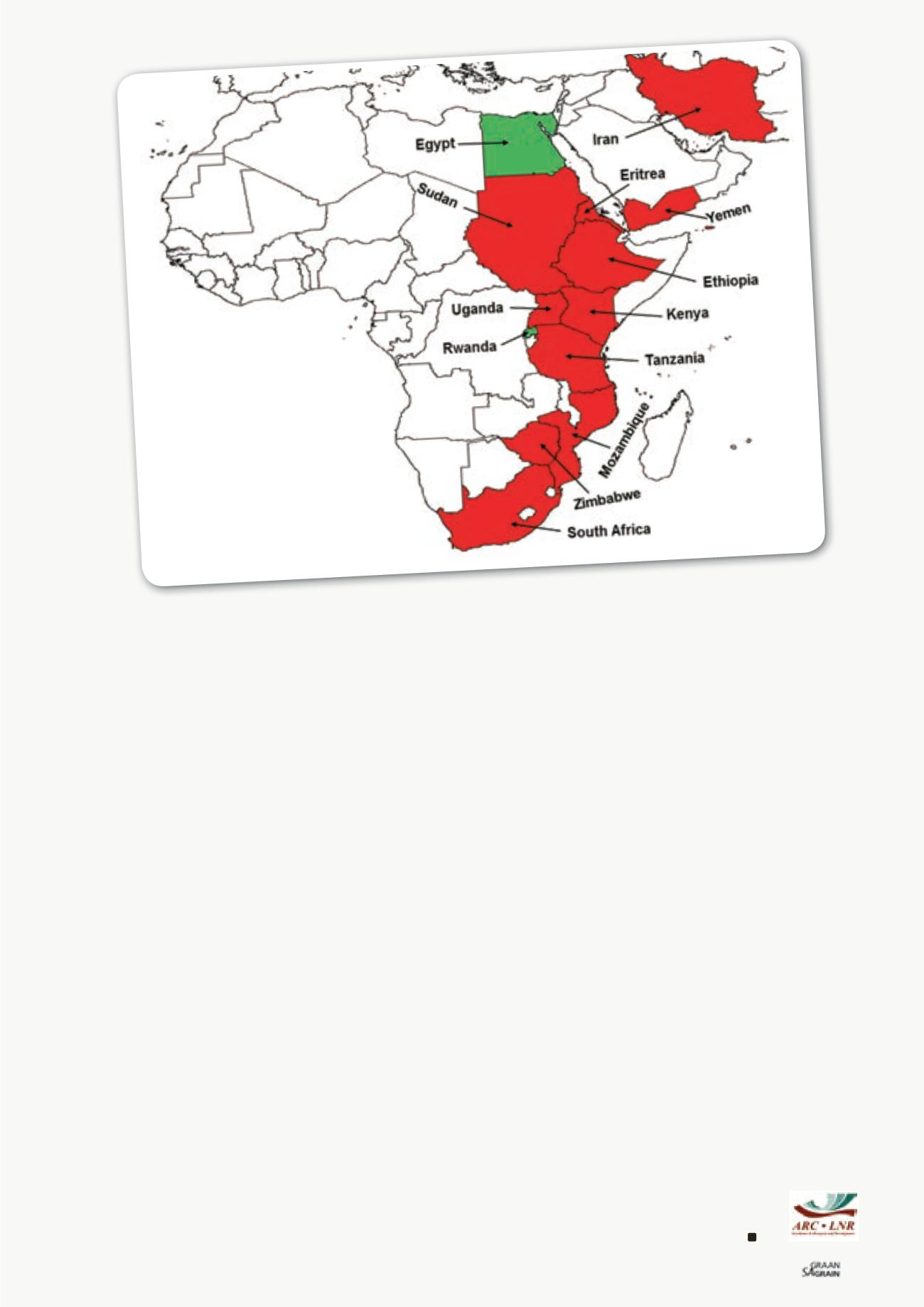

57
September 2015
ARC-SGI programme to quickly determine
the presence of targeted gene combinations
in a specific wheat line, thereby comple-
menting conventional methods of breeding
for rust resistance.
Is Ug99 also expanding its
geographical territory?
Yes, rust pathogens including Ug99 are not
only variable, but they are also mobile. They
can spread between places by their wind-
borne spores. They can accidentally be
transported from one place to another by
sticking to clothes and shoes of people.
Up until the end of 2013, Ug99 variants were
confirmed in eleven countries. However,
the global rust monitoring system, which
was established as part of the BGRI to de-
tect and track virulent rust races such as the
Ug99, reported that race TTKSK (Ug99) was
detected in Egypt for the first time in 2014.
Similarly, two variants of Ug99 were de-
tected for the first time in Rwanda in
2014 (
Figure 1
). Thus, during the past
15 years, Ug99 variants have expanded
their geographical territory to over 13 coun-
tries. To date, one or more of the eleven
Ug99 race groups have been confirmed
in Egypt, Eritrea, Ethiopia, Iran, Kenya,
Mozambique, Rwanda, South Africa,
Sudan, Tanzania, Uganda, Yemen and
Zimbabwe (Figure 1).
Four of the eleven Ug99 variants have been
confirmed in South Africa. The last time a
new Ug99 variant was detected in South
Africa was in 2010 when 2SA88+ (TTKSF+)
were first detected at Afrikaskop in the Free
State. There was not a significant shift in the
distribution and frequency of these races
in South Africa during the last five years.
Upon first detection of the different Ug99
variants in South Africa, effective resist-
ance genes were identified and a selection
of such genes is being utilised in breeding
programmes.
Ug99 variants may not be as threatening to
wheat production in South Africa as they
would be in the wheat producing countries
of East Africa and Asia, where highly sus-
ceptible cultivars are widely grown. Detailed
information about Ug99 variants detected in
South Africa has recently been published in
SA Graan/Grain
16(8): 91 - 93, August 2014.
Timeous detection and
control
Do we have the tools and expertise in South
Africa to allow timeous detection and con-
trol of potentially harmful rusts, as is being
done by the global rust monitoring system?
Yes, the ARC-SGI is responsible for the
Southern African National Rust Surveillance
Programme and it is one of only four rec-
ognised laboratories worldwide to conduct
these surveys. The end-goal of the rust
monitoring programme is to predict rust
outbreaks in wheat in our region and to act
pro-actively. The surveillance programme
was launched plus minus 40 years ago and
is still able to detect potential outbreaks
before they become widespread. Until re-
cently we’ve been identifying rust races
based on their virulence on seedlings of
differential lines. We have however recently
established collaboration with researchers
from the University of the Free State, to use
the latest developed biotechnology tech-
niques in the genetic characterisation (fin-
ger printing) of these rust races in addition
to the conventional biotyping methods.
These virulence tests identify races only
from viable spores, but the molecular tech-
niques utilise the DNA of spores whether
the spores are viable or not, thereby making
the process of race identification more ac-
curate and complete.
Any other effort by the
ARC-SGI to combat these
ever changing rust patho-
gens?
In an effort to stay ahead of highly virulent
races including Ug99 variants that are not
yet detected in South Africa, the ARC-SGI
has been annually screening South African
wheat cultivars and breeding material at the
International Stem Rust Screening Nursery
in Kenya. As a result, quite a lot of material
which are resistant to Ug99 variants and
other highly virulent races prevalent in East
Africa has been identified. Some of these
resistance sources are be-
ing used in the breeding pro-
grammes in the ARC-SGI as a
pro-active intervention.
Figure 1: Countries where Ug99 variants were detected during the past 15 years.

















